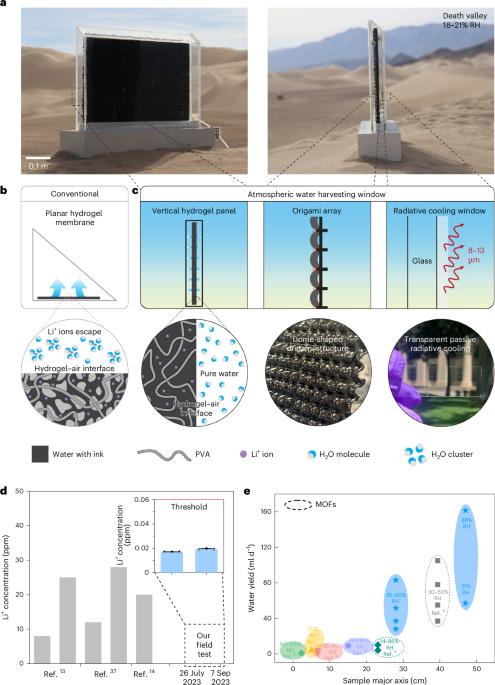A metre-scale vertical origami hydrogel panel for atmospheric water harvesting in Death Valley
IF 24.1
引用次数: 0
Abstract
Water scarcity impacts over 2.2 billion people globally, especially in underdeveloped, landlocked or off-grid regions. Passive sorbent-based atmospheric water harvesting offers a promising solution by converting ubiquitous atmospheric moisture into liquid water. However, current approaches are limited by low water production (a few millilitres a day), the release of unsafe lithium ions and poor efficiency in conditions of low relative humidity. Here we report an atmospheric water harvesting window (AWHW) featuring a vertical origami hydrogel panel and a window-like solar still. This passive, metre-scale device was tested in Death Valley, producing 57.0–161.5 ml of water a day across a relative humidity range of 21–88%. The device has a lifespan of at least 1 year and delivers safe water with lithium ion concentrations below 0.06 ppm. Our AWHW sets a benchmark in daily water production and climate adaptability, representing an advance towards practical, scalable, safe and sustainable decentralized water solutions for the most water-stressed regions. Water scarcity is a global issue that demands urgent resolution, but current approaches are inadequate. Now a metre-scale atmospheric water harvester, featuring a hygroscopic origami hydrogel panel and a window-like glass chamber, demonstrates exceptional efficiency in extracting water from air, even in extremely arid conditions.

一个米尺度的垂直折纸水凝胶板,用于收集死亡谷的大气水
水资源短缺影响着全球超过22亿人,特别是在欠发达、内陆或离网地区。被动吸附剂为基础的大气水收集提供了一个有前途的解决方案,将无处不在的大气水分转化为液态水。然而,目前的方法受到产水量低(每天几毫升)、释放不安全的锂离子以及在低相对湿度条件下效率低的限制。在这里,我们报道了一种大气集水窗(AWHW),它具有垂直折纸水凝胶面板和窗口状太阳能蒸馏器。这种被动的米级装置在死亡谷进行了测试,在相对湿度为21-88%的范围内,每天产生57.0-161.5毫升的水。该设备的使用寿命至少为1年,并提供锂离子浓度低于0.06 ppm的安全水。我们的AWHW在日常用水和气候适应性方面树立了一个基准,代表着为最缺水地区提供实用、可扩展、安全和可持续的分散式水解决方案的进步。水资源短缺是一个需要紧急解决的全球性问题,但目前的方法是不够的。现在,一种一米尺度的大气水收集器,具有吸湿折纸水凝胶面板和窗户状的玻璃室,即使在极端干旱的条件下,也能从空气中提取水。
本文章由计算机程序翻译,如有差异,请以英文原文为准。
求助全文
约1分钟内获得全文
求助全文

 求助内容:
求助内容: 应助结果提醒方式:
应助结果提醒方式:


